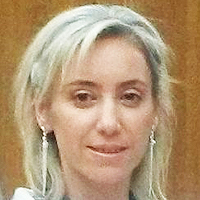Pediatric Dysgerminoma: Unveiling a Rare Ovarian Tumor
Published on: 19th January, 2024
Background: Dysgerminomas, account for only 1% - 2% of all malignant ovarian neoplasms.Objective: This case report aims to present a rare occurrence of dysgerminoma in a pediatric patient, highlighting the clinical characteristics, diagnosis, and management.Case presentation: We present a case of dysgerminoma in a 12-year-old girl who presented with a three-week history of pelvic pain and progressive abdominal swelling. Physical examination revealed a distended abdomen with evident suprapubic fullness, and a palpable abdominopelvic mass measuring approximately 20 weeks in size. Imaging studies confirmed the presence of a solid heterogeneous mass originating from the pelvis. The patient underwent a right salpingo-oophorectomy without complications. Histological examination coupled with an immunohistochemical study confirmed the diagnosis of dysgerminoma. The patient had an uneventful postoperative course and was discharged without adjuvant treatment. Regular follow-up visits, physical examinations, ultrasound scans, and lactate dehydrogenase assays were initiated for monitoring. Conclusion: Prompt recognition and appropriate surgical intervention, followed by regular monitoring, are crucial for optimal outcomes in pediatric dysgerminoma cases.
Optimizing Milk Safety: Applying Nuclear Techniques in X-ray Fluorescence Spectroscopy for Heavy Metal Quantification in Powdered Milk Consumed in Senegal
Published on: 9th February, 2024
This study conducted an elemental analysis and assessed heavy metal concentrations in five powdered milk samples (V1, L1, H1, G1, and D1) from Senegal, utilizing X-ray Fluorescence (XRF). The analysis focused on aluminum (Al), calcium (Ca), potassium (K), phosphorus (P), and chlorine (Cl). Aluminum was either undetected or found at negligible levels in all samples. Calcium levels consistently surpassed the Acceptable Maximum Level (AML) in all samples, with H1 exceeding the AML by approximately 11.1 times (27,745.06 ± 310.16 ppm). Potassium concentrations varied, with G1 exhibiting the highest levels, significantly exceeding the AML (51,058.15 ± 456.13 ppm), while V1 remained within acceptable limits. Chlorine concentrations generally complied with the AML, except for G1, which slightly exceeded the limit (3631.04 ± 31.23 ppm). Phosphorus concentrations in H1 were notably higher than the AML (13,750.94 ± 275.35 ppm). The non-uniformity in heavy metal concentrations among samples emphasizes the need for ongoing research and regulatory scrutiny to address potential risks and ensure the safety of powdered milk.
Assessment of the Quality of Life of the Caregiver of Pediatric Patients with Chronic Kidney Disease in a Tertiary Health Care Facility
Published on: 6th March, 2024
Background: Long-term care for patients with chronic kidney disease, whether in the pre or post-dialysis period, has a destructive impact on patients and their caregivers that can significantly worsen their quality of life. Objectives: To assess the quality of life (QOL) among caregivers of children suffering from chronic kidney disease and to identify the possible factors affecting their quality of life. Subjects and methods: Between March 2023 and May 2023, a cross-sectional questionnaire-based study was conducted at King Saud Medical City for caregivers of all pediatric patients aged from 6 months to 14 years with CKD stage-3B and beyond who have been followed up for at least three months in the pre or post-dialysis period since 2015. The study applied the World Health Organization Quality of Life Questionnaire (WHOQOL-BREF) to evaluate the caregivers’ quality of life. Result: A total of 95 caregivers were involved in the study. The age ranged between 24 and 53 years, with an arithmetic mean of 39.3 and a standard deviation of (± 6.6) years, and almost two-thirds (65.3%) were Saudi nationals. Most pediatric patients were on peritoneal renal dialysis (41%), whereas 29.5% were on hemodialysis. The mean and SD of the overall score was 56.10 ± 17.40 out of a possible range of 0-100. Regarding its domains, the highest score was observed regarding the social domain (62.11 ± 21.12), whereas the lowest was the physical domain (49.55 ± 18.42). After controlling for confounding, married, high socio-economic, and more educated caregivers have higher QOL scores than singles, low socio-economic, and lower knowledgeable caregivers, and the three factors together were responsible for approximately 41% variability of the QOL score (r – square = 0.406). Bivariate Pearson correlation showed significant correlations among different quality-of-life domains (p < 0.001). Conclusion: There was a significant association between quality-of-life scores and demographic characteristics of chronic kidney disease caregivers; they need the highest support to cope with their delicate patients.
A Low-cost High-throughput Targeted Sequencing for the Accurate Detection of Respiratory Tract Pathogen
Published on: 12th March, 2024
Introduction: The current gold standard for SARS-CoV-2 diagnosis by real-time RT-PCR has limitations of gene numbers that can be detected. In this study, we developed a low-cost and high-throughput next-generation sequencing technology that can overcome the limitations of RT-PCR. Methodology: A targeted sequencing panel (TSP) consisting of approximately 500 amplicons was designed that can simultaneously detect a broad range of gene loci of SARS-CoV-2 and genes for the most common viruses of respiratory infectious viruses in a single run of up to 96 samples. 448 samples and 31 control samples were examined independently with both TSP and RT-PCR, results were compared for accuracy and other indicators. Results: TSP identified 50 SARS-CoV-2 positive samples with a 99.33% match to RT-PCR results. It is not surprising that TSP also identified multiple viral infections from 96 samples, whereas RT-PCR could not. TSP demonstrated its ability to conclude diagnosis for those undecided from RT-PCR tests. Conclusion: Our data demonstrated that TSP is a fast and accurate test for detecting multiple pathogen infections of the respiratory tract.
Management and Therapeutic Strategies for Spinal Muscular Atrophy
Published on: 29th March, 2024
Spinal muscular atrophy is an autosomal recessive neuromuscular disorder characterized by progressive muscle weakness and atrophy. It is one of the most common single-gene disorders with an incidence rate of approximately 1 in 10,000 live births. The clinical manifestations are progressive hypotonia and muscle weakness due to the degeneration of alpha neurons in the anterior horn cells of the spinal cord and motor nuclei in the lower brain stem. Depending on the severity of the symptoms, SMA has five subtypes. Supportive measures can be offered for respiratory, gastrointestinal, and musculoskeletal complications. Carrier testing for all couples is recommended and this can be done by Multiplex Ligation-dependent Probe Amplification (MLPA). Prenatal diagnosis can be offered to carrier couples. Therapies must be given within the newborn period for maximum benefit and before the loss of motor neurons. It is achieved by identifying the SMA babies through Newborn screening. Several new FDA-approved drugs can reduce the progression of symptoms in SMA. However, they cannot offer a definite cure. Clinical follow-up and Neurological assessment demonstrate that SMA children can attain developmental milestones after receiving treatment, which is never normally attained in untreated cases. In utero SMA treatment with Zolgensma would enhance the survival rate and favorable neurological outcomes in the future. Base editing and Gene editing with CRISPR-Cas technologies to target the mutations and restore functional and stable SMN protein levels are the future hopes for a permanent cure of SMA.
Oral Cancer Management is not just Treatment! But also, how early Pre-cancerous Lesions are Diagnosed & Treated!!
Published on: 12th April, 2024
Oral Cancer (OC) or squamous cell carcinoma of the oral cavity accounts for approximately 3% of all cancers worldwide, with increased incidence in developing countries. The use of tobacco is directly associated with approximately 80% of oral cancers, especially in older men over 40 years of age. As nearly one-third of the Indian population over 15 years consume smokeless tobacco in one or the other forms, a recent increase has been observed in OC incidence among women and young adults. Lately, the sexual behaviors of young & homosexuals have resulted in the emergence of oropharyngeal cancers due to infection with HPV 16. About 60% of oral cancer cases in India have a five-year survival rate, and this can be improved to 70% to 90% by mere early detection in stages I and II and with various treatment modalities. Despite the well-known benefits of oral cancer screening for the whole population in developing countries remains controversial. It is imperative to address the cultural barriers and societal norms, which limit the acceptability and participation in screening programs in India and many developing countries. This unique challenge of increasing OC morbidity in India and developing countries requires horizontal integration of the health systems with new services focused on cancer control, which gives the best chance for long-term survival, improved outcomes, and affordable care!This article is based on the author’s experience of overseeing 1 case of early detection and 2 cases of delayed diagnosis, outcomes and relevant literature review, and current guidelines for the management of OC.

HSPI: We're glad you're here. Please click "create a new Query" if you are a new visitor to our website and need further information from us.
If you are already a member of our network and need to keep track of any developments regarding a question you have already submitted, click "take me to my Query."
















